manual transmission CHEVROLET S10 1993 2.G Owners Manual
[x] Cancel search | Manufacturer: CHEVROLET, Model Year: 1993, Model line: S10, Model: CHEVROLET S10 1993 2.GPages: 356, PDF Size: 20.85 MB
Page 53 of 356

Downloaded from www.Manualslib.com manuals search engine Features & Controls
Here you can learn about the many standard and optional featur\
es on your
vehicle, and information on starting, shifting, and braking. Als\
o explained are
the instrument panel and the warning systems that tell you
if everything is
working properly-and what to do if you have a problem.
For explanation of vehicle symbols, refer to “Vehicle Symbols” in
Section 0.
Keys ......................,.........................,...........~...........\
...............................,...........,. 2-3
Your Doors and How They Work
............................................~.......................... \
2-5
Side Doors
.............I............r............................ .................................... .... ......... 2-5
Door Locks
........................................................................\
.................................. .- . , 2-6
Theft
........................................................................\
............................................... 2-8
New Vehicle Break-In
........................................................................\
............,...... 2-9
Ignition Switch
........................................................................\
............................... 2-9
Starting Your Engine
........................................................................\
................... 2-11
Driving Through Deep Standing Water
..................................................... .... 2-14
Automatic Transmission
........................................................................\
.............. 2-1 6
Five-Speed Manual Transmission ...................................................................... 2-1 9
Locking Rear
Axle ...... 1 ........................................................................\
................ 2-21
Parking Brake
........................................................................\
.............................. 2-21
Parking Over Things That Burn
........................................................................\
. 2-25
-
2-1
Page 60 of 356
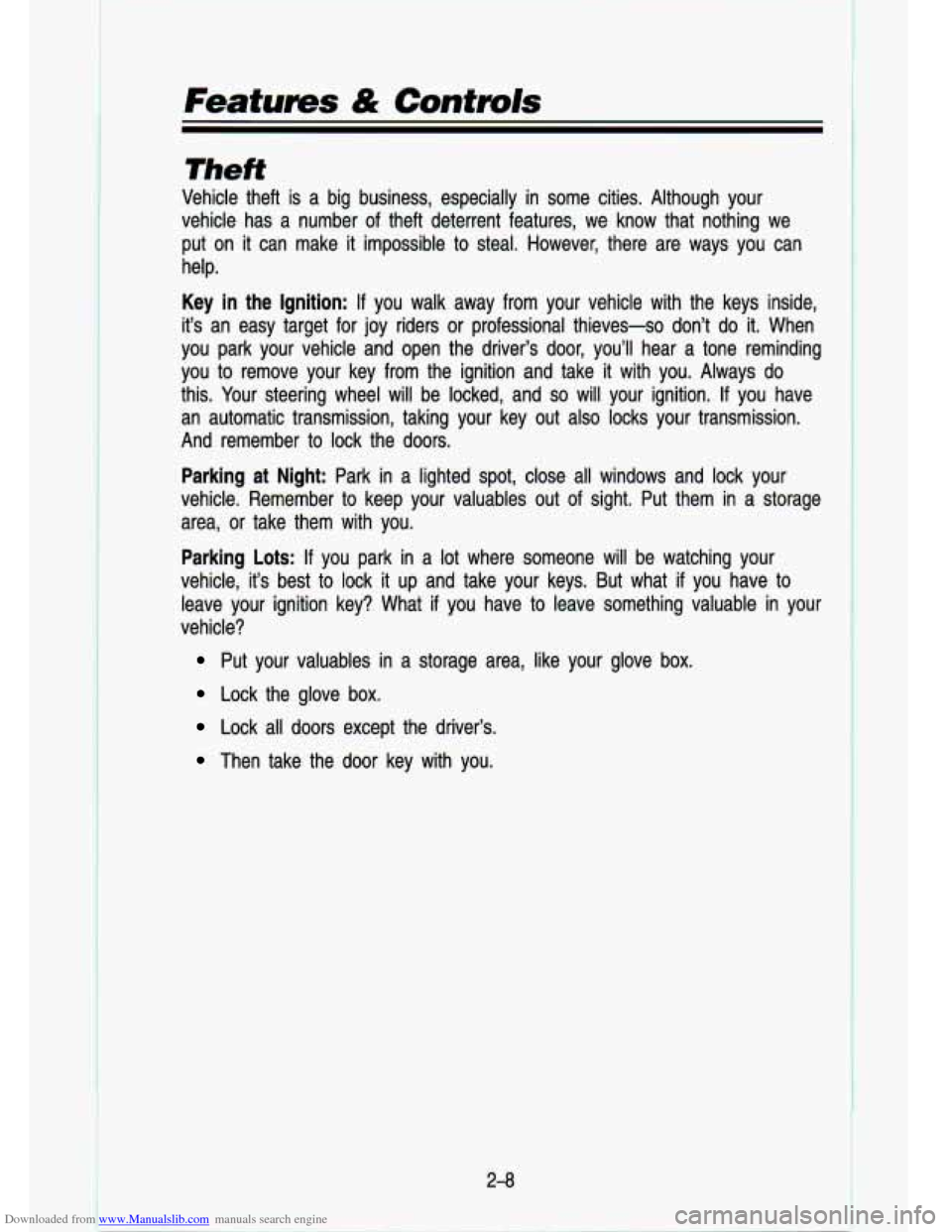
Downloaded from www.Manualslib.com manuals search engine Theft
Vehicle theft is a big business, especially in some cities. Although your
vehicle has a number of theft deterrent features, we know that nothing we
put on
it can make it impossible to steal. However, there are ways you can
help.
Key in the Ignition:
If you walk away from your vehicle with the keys inside,
it’s an easy target for joy riders or professional thieves-s\
o don’t
do it. when^
you park your vehicle and open the driver’s door, you’ll \
hear a tone reminding
you to remove your key from the ignition and take it with you. Always
do
this. Your steering wheel will be locked, and so will your ignition. If you have
an automatic transmission, taking your key out also locks your \
transmission.
And remember to lock the doors.
Parking at Night: Park in a lighted spot, close all windows and lock your
vehicle. Remember to keep your valuables out of sight. Put them in a storage
area, or take them with you.
Parking Lots:
If you park in a lot where someone will be watching your
vehicle, it’s best to lock it up and take your keys. But what
if you have to
leave your ignition key? What
if you have to leave somethina valuable in vour
vehicle?
Put your valuables in a storage area, like your glove DOX.
Lock the glove box.
Lock all doors except the driver’s.
Then take the door key with you.
2-8
1
Page 62 of 356

Downloaded from www.Manualslib.com manuals search engine .. ~ .
.. ..
Features & Contmls
LOCK: This position locks your ignition, steering wheel and tra\
nsmission. It’s
a theft deterrent feature. You will only be able to remove your key when the
ignition
is turned to LOCK.
Off: This position lets you turn off the engine but still turn the steering wheel
like LOCK. Use Off if you must have your vehicle in motion while the engine
is
off (for example, if your vehicle is being pushed).
Run: This is the position for driving.
Start: This starts your engine.
On manual transmission vehicles, turning the key to
“LOCK’ will lock
vehicle. This coiu18d cause am collision. If you need to turn the engiw
off Mhile the vehicle is moving, turn the key only to “OW. Don’t
mve the key release lever while the vehicle is moving.
- the steering column an’d result in a loss of ability to steer the
2-1 0
Page 63 of 356
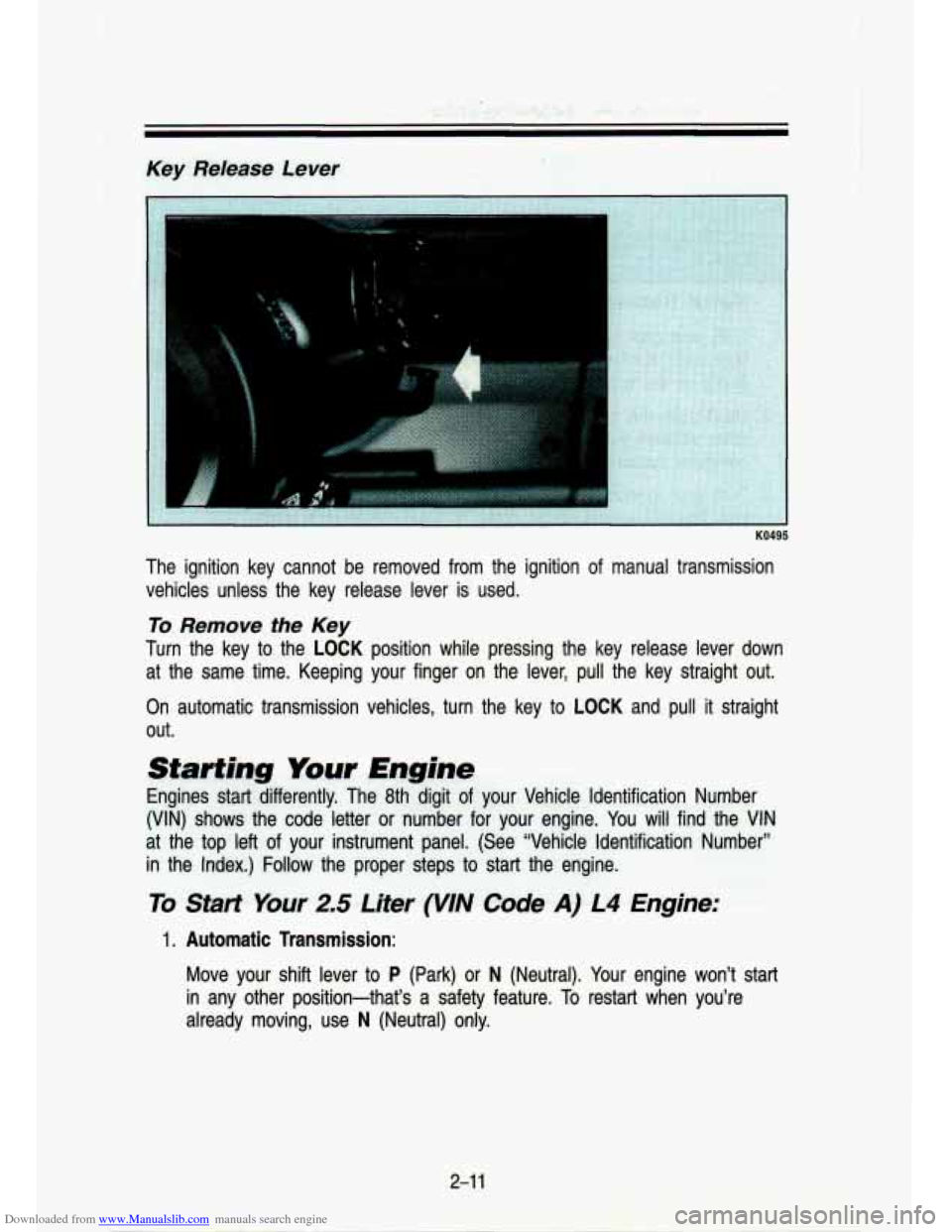
Downloaded from www.Manualslib.com manuals search engine Key Release Lever
The ignition key cannot be removed from the ignition of manual transmission
vehicles unless the key release lever is used.
To Remove the Key
Turn the key to the LO,CK position while pressing the key release lever down
at the same time. Keeping your finger on the lever, pull the \
key straight out.
On automatic transmission vehicles, turn the key to LOCK and p\
ull it straight
out.
To Starz Your 2.5 -Liter (VIN Code A) L4 Engine:
1. Automatic Transmission:
Move your shift lever to
P (Park) or N (Neutral). Your engine won't start
in any other position-that's a safety feature.
To restart when you're
already moving, use
N (Neutral) only.
2-1 1
Page 64 of 356

Downloaded from www.Manualslib.com manuals search engine ..
Features & Controls
1 NOTICE
Don’t try to shift to P (Park) if your vehicle is movi
:auld dal ae ? transrnissil SI ark‘ nE
Manual Transmission:
Shift your gear selector to
N (Neutral) and hold the clutch pedal to the
floor while starting the engine. Your vehicle won’t start
if the clutch pedal
is not all the way down-that’s a safety feature.
other vehicles you might need to
do this, but because of your vehicle’s
computer systems, you don’t.
key. The idle speed will
go down as your engine gets warm.
2. Don’t push the accelerator pedal before starting your engine.\
In some
-
3. Turn your ignition key to Start. When the engine starts, let go of the
In very cold weather,
do this:
1. With your foot off the accelerator pedal, turn your ignition key to Start
until your engine begins firing. Push down on the accelerator pedal
slightly. When the engine picks up speed, let go of the key. \
Once your
engine is running smoothly, let up on the accelerator pedal.
2. If it doesn’t start right away, push the accelerator pedal all the way to
the floor and hold it there as you hold the key in
Start for about three
seconds.
If the vehicle starts briefly but then stops again, do the same
thing, but this time keep the pedal down until your engine ru\
ns smoothly.
NOTICE b___
2-1 2
t
Page 65 of 356
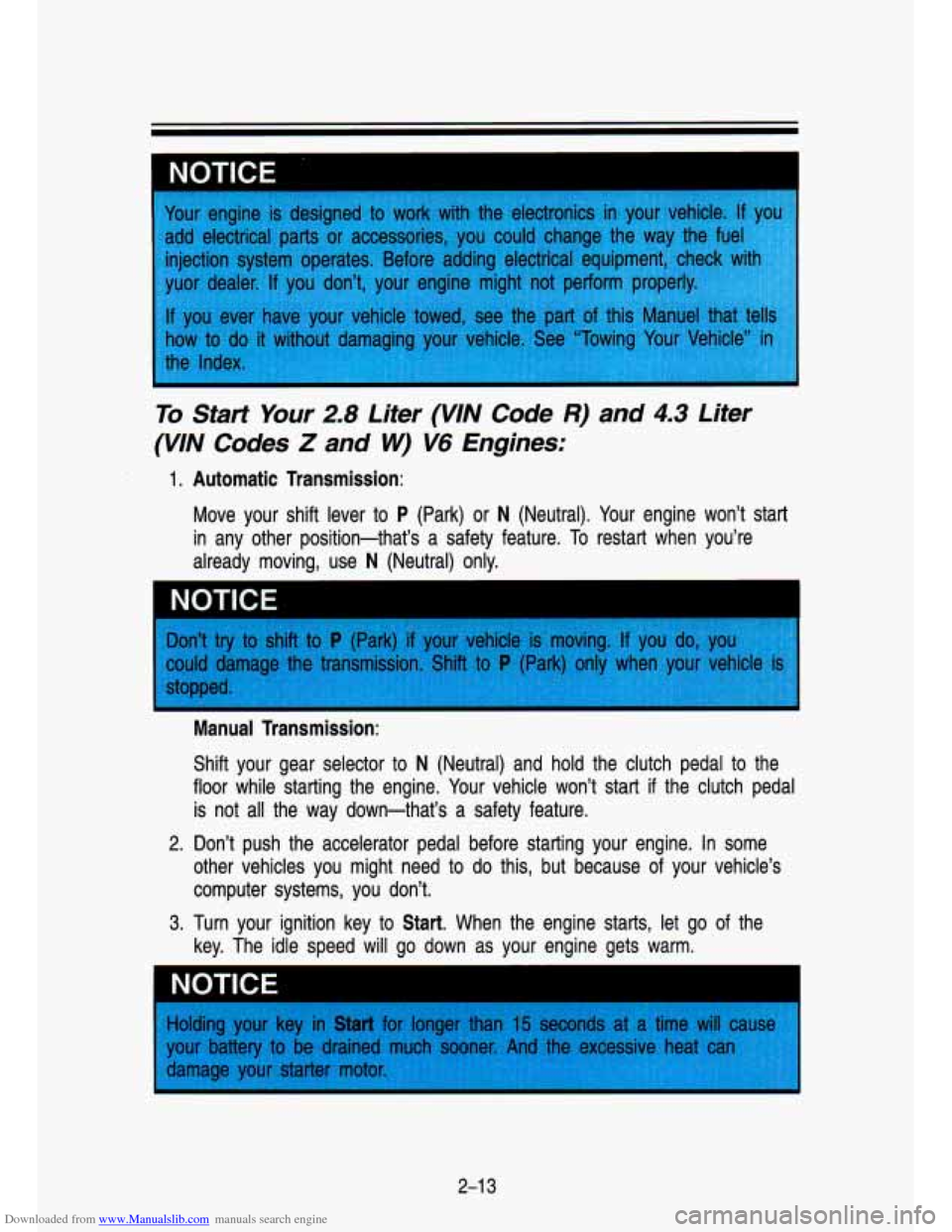
Downloaded from www.Manualslib.com manuals search engine NOTICE
I
ever nave your venue loweu, see 11
now IO do it without damaging your v-’-’cle
the Index.
To Start Your 2.8 Liter (W/V Code R) and 4.3 Liter
(VlN Codes Z and W) V6 Engines:
1. Automatic Transmission:
Move your shift lever to
P (Park) or N (Neutral). Your engine won’t start
in any other position-that’s a safety feature. To restart when you’re
already moving, use
N (Neutral) only.
I NOTICE
Manual Transmission:
Shift your gear selector to
N (Neutral) and hold the clutch pedal to the
floor while starting the engine. Your vehicle won’t start
if the clutch pedal
is not all the way down-that’s a safety feature.
other vehicles you might need to
do this, but because of your vehicle’s
computer systems, you don’t.
key. The idle speed will go down as your engine gets warm.
2. Don’t push the accelerator pedal before starting your engine. In some
3. Turn your ignition key to Start. When the engine starts, let \
go of the
I
2-1 3
Page 69 of 356

Downloaded from www.Manualslib.com manuals search engine I CAUTION
I A It is.-dangerous to get out of..your vehicle if. tha..shift lever is not fully
in-P (ParQ--wiih
the parking brake fiim~ljj-set. Yo’ur vehiclle ‘&n roll.
Doln’t leave your vehicle when the engine is running unless you have
to.
If you have left the engine running, tihe vehicle can move
suddenly. You or others could- be injured.
To be sure your vehicle
won’t move, when yolu’lre on fairly level ground, always set your
parking brake and move the shift lever to P (Park).
Of you have four-wheel drive, your vehicle will be free to roll-even if
your shift lever is in P (Park)i-if your transfer case i:s iln ‘N (Neutral).
So be sure the transfer case is in a drive gear-not in N (Neutral)’.
See “Shifting into P (Par’k)’’ in the Index. If you are ,parking on a hill,
or, if you’re p’ulling a traihr, also see “Parking on Hills” o:r “Towilnlg a
Trailer” in the Index.
R (Reverse). Use this gear to back up.
To rock your vehicle back and forth to get out of snow, ice or \
sand without
damaging your transmission, see
“If You’re Stuck in Sand, Mud, Ice or Snow”
in the Index.
N (Neutral). In this position, your engine doesn’t connect wi\
th the wheels.
To restart when you’re already moving, use N (Neutral) only. Also, use N
(Neutral) when your vehicle is being towed.
Shifting
out of P (Park) or N (Neutral) While your engine is “racing”
a (iunning aft hligh speed) is dangerous. ‘Unless your foot is firmly on
the brake ped’al,
your vehilcle could move very rapidly. You co1wl;d lose
(Neutral) while your engine is racing.
I contro’l and hit people or objects. Don’t shift out ‘of P (Park) or N
2-1 7
Page 70 of 356
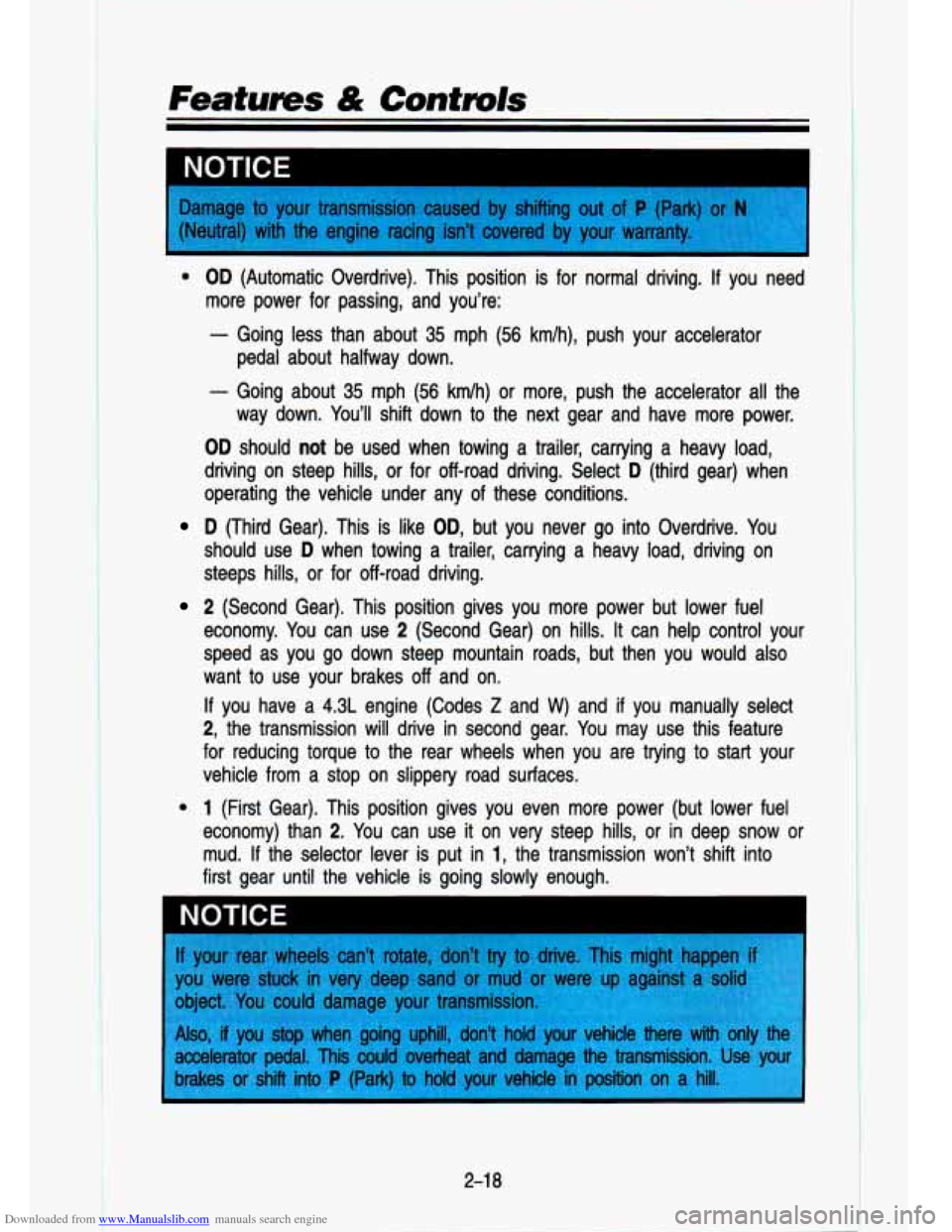
Downloaded from www.Manualslib.com manuals search engine Features & Controls
I
e
OD (Automatic Overdrive). This position is for normal driving. If you need
more power for passing, and you’re:
- Going less than about 35 mph (56 km/h), push your accelerator
pedal about halfway down.
- Going about 35 mph (56 km/h) or more, push the accelerator all the
way down. You’ll shift down to the next gear and have more power.
OD should not be used when towing a trailer, carrying a heavy load,
driving on steep hills, or for off-road driving. Select
D (third gear) when
operating the vehicle under any of these conditions.
D (Third Gear). This is like OD, but you never go into Overdrive. You
should use
D when towing a trailer, carrying a heavy load, driving on
steeps hills, or for off-road driving.
2 (Second Gear). This position gives you more power but lower \
fuel
economy. You can use
2 (Second Gear) on hills. It can help control your
speed as you go down steep mountain roads, but then you would\
also
want to use your brakes off and on.
If you have a 4.3L engine (Codes Z and W) and if you manually select
2, the transmission will drive in second gear. You may use this feature
for reducing torque
to the rear wheels when you are trying to start your
vehicle from a stop on slippery road surfaces.
1 (First Gear). This position gives you even more power (but \
lower fuel
economy) than
2. You can use it on very steep hills, or in deep snow or
mud. If the selector lever is put in 1, the transmission won’t shift into
first gear until the vehicle is going slowly enough.
2-1 8
Page 71 of 356
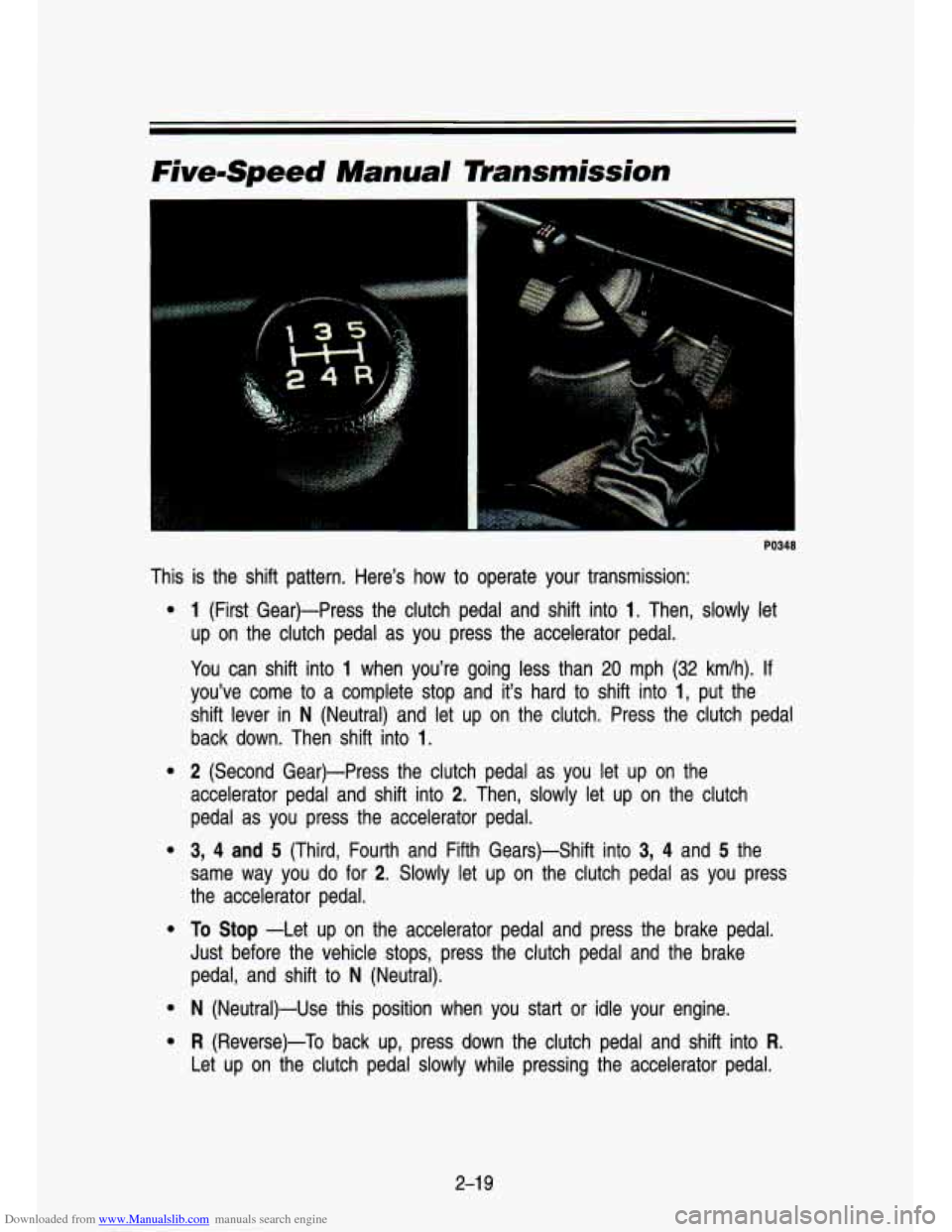
Downloaded from www.Manualslib.com manuals search engine FivemSpeed Manual Transmission
PO348
This is the shift pattern. Here’s how to operate your transmission:
e
e
e
e
e
e
1 (First Gear)-Press the clutch pedal and shift into 1. Then, slowly let
up on the clutch pedal as you .press the accelerator pedal.
You can shift into
1 when you’re going less than 20 mph (32 km/h). If
you’ve come to a complete stop and it’s hard to shift into 1, put the
shift lever in
N (Neutral) and let up on the clutch. Press the clutch pedal
back down. Then shift into
1.
2 (Second Gear)-Press the clutch pedal as you let up on the
accelerator pedal and shift into
2. Then, slowly let up on the clutch
pedal as you press the accelerator pedal.
3, 4 and 5 (Third, Fourth and Fifth Gears)-Shift into 3, 4 and 5 the
same way you do for
2. Slowly let up on the clutch pedal as you press
the accelerator pedal.
To Stop -Let up on the accelerator pedal and press the brake pedal.
Just before the vehicle stops, press the clutch pedal and the \
brake pedal, and shift to
N (Neutral).
N (Neutral)-Use this position when you start or idle your engin\
e.
R (Reverse)-To back up, press down the clutch pedal and shift into R.
Let up on the clutch pedal slowly while pressing the accelerat\
or pedal.
2-1 9
Page 72 of 356
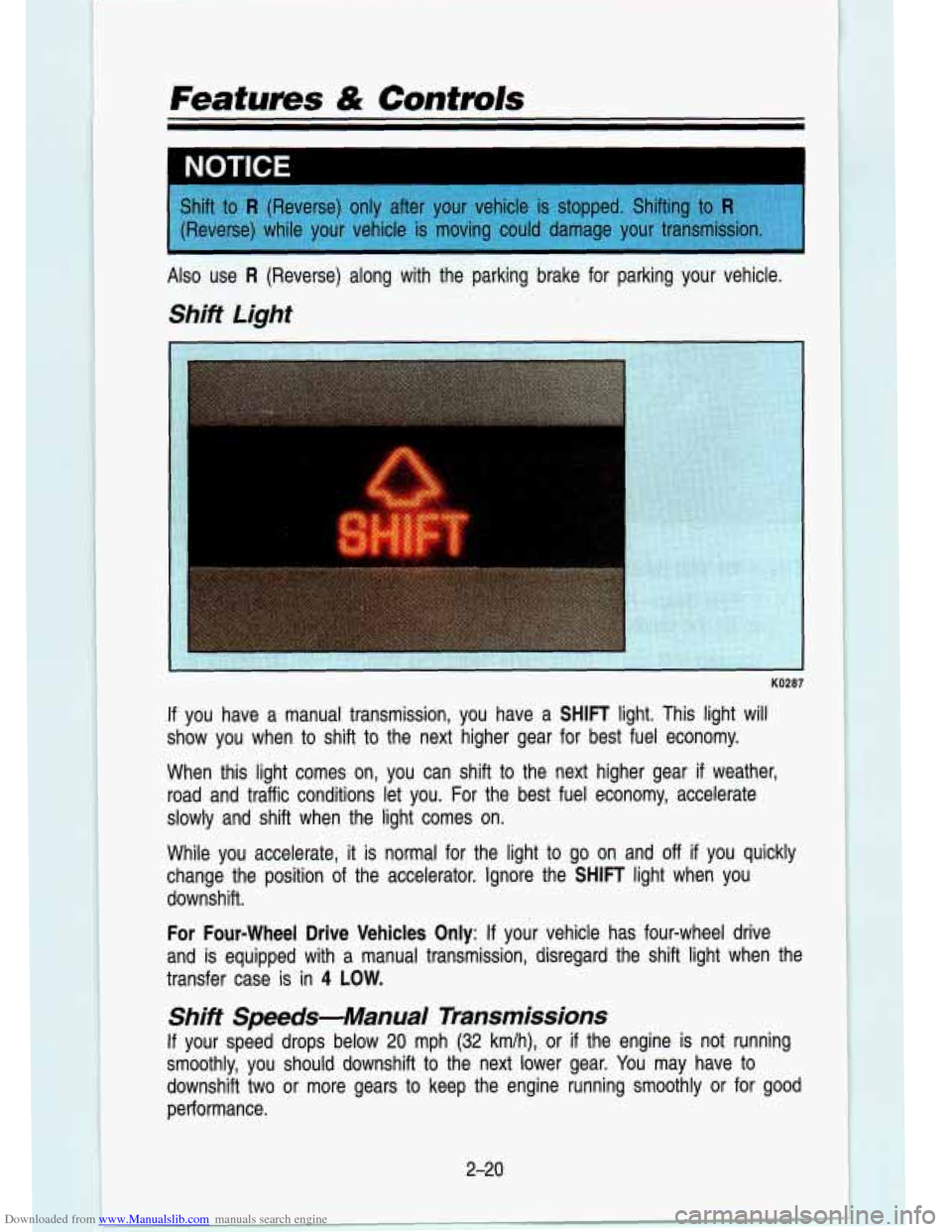
Downloaded from www.Manualslib.com manuals search engine Featurns & Controls
I
If you have a manual transmission, you have a SHIFT light. This light will
show you when
to shift to the next higher gear for best fuel economy.
When this light comes on,
you can "shift to the n-ext higher gear if weather,
road and traffic conditions let you. For the best fuel economy, accelerate
slowly and shift when the light comes on.
While you .accelerate, it
is normal for the light to go on and off if you quickly
change the position
of the accelerator. Ignore the SHIFT light when you
downshift.
For Four-wheel Drive Vehicles
Only: If your vehicle has four-wheel drive
and is equipped with a manual transmission, disregard the shift\
light when the
transfer case is in
4 LOW.
Shift Speeds-Manual Transmissions
If your speed drops below 20 mph (32 km/h), or if the engine is not running
smoothly, you should downshift
to the next lower gear. You may have to
downshift two or more gears to keep the engine running smoothly or for good
performance.
2-20